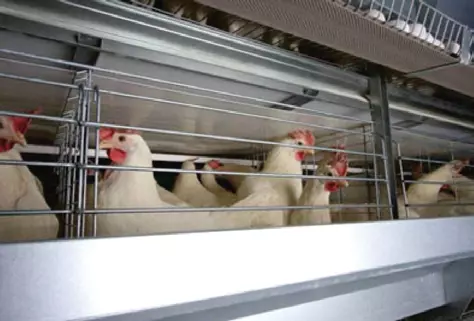Requirements for the construction of chicken cages
2025-03-28
In caged layer farming, hens generally enter cages at 18-20 weeks of age and are culled at 72 weeks of age, completing one production year. Therefore, in addition to good chicken coop environmental conditions, a rationally structured cage is necessary to enable laying hens to achieve their highest production efficiency.
The size of the hen cage must meet certain activity area, feeding position and height requirements. Simultaneously, to allow laid eggs to roll out of the cage promptly, the cage floor should have a certain inclination. Based on these requirements, the arrangement of hen cages should consist of many small individual cages. Each small individual cage houses 2, 3, or 4-5 hens.
The dimensions of a single hen cage are generally: front height 445-450 mm, rear height 400 mm, cage floor slope 9-10 degrees, cage depth 310-350 mm, and egg collection trough extending outside the cage 120-160 mm. The cage width depends on the feeding position; each hen requires 100-110 mm of feeding space. A cage for 2 hens is 250 mm wide, for 3 hens 300 mm wide, and for 4-5 hens 420-450 mm wide.
There are two forms of single cage manufacturing and installation: integral and assembled. The integral type combines several unit cages into a whole. Its advantage is convenient installation, but it consumes more materials, is difficult to transport after completion, and is prone to deformation. The assembled type uses an overall cage frame. After the overall cage frame is installed, the individual cage nets are hung on it. Its advantages are neat installation, and convenient replacement and maintenance. In actual production, the assembled type is more common.
The various cage nets of the individual cages are generally made of cold-drawn steel wire spot-welded together, but the functions of the various cage nets are different, and their material thickness and mesh size have different requirements.
The side and rear nets mainly serve as partitions for the cage body. Metal wire with a diameter of 2-2.5 mm can be used, arranged in a horizontal grid. The longitudinal direction uses thicker wire on the outside, with a spacing of 100-200 mm; the latitudinal direction uses thinner wire on the inside, with a spacing of 30 mm. This prevents hens from pecking at each other through the cage.
The bottom net must not only bear a certain weight but also allow droppings to fall through while retaining eggs. It should also have a certain elasticity so that eggs are not easily broken when laid and the hens have a certain level of comfort when moving. Therefore, metal wire with a diameter of 2.5-3.0 mm is used, arranged in a vertical grid. The longitudinal direction uses thicker wire on the top, with a spacing of 22-25 mm; the latitudinal direction uses thinner wire on the bottom, with a spacing of 50-60 mm. This allows eggs to roll smoothly along the longitudinal slope.
The width of the cage door varies with the width of the individual cage. It is generally welded from 3 mm diameter metal wire into a vertical railing with a spacing of 50-60 mm. The cage door is 400 mm high, and its lower edge should be 50-55 mm from the bottom net to leave a space for eggs to roll; or an egg protection plate can be added 50 mm from the lower edge, extending into the cage at an angle, to prevent eggs in the egg collection trough from being pecked by hens, and to prevent chicken droppings from entering the feed and water troughs.
In addition, to extend the service life of cold-drawn steel wire cages, anti-corrosion measures such as galvanizing can be adopted.
Next
Next
Related Articles



